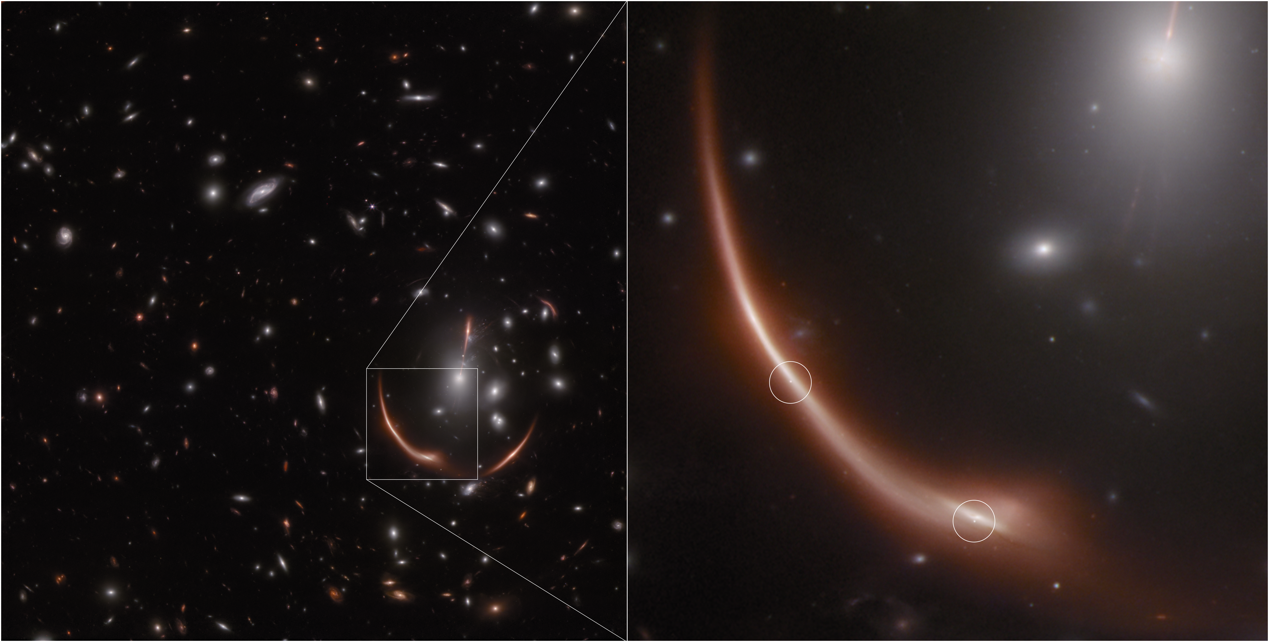Pixelized Galaxy Cluster Strong Lens Modeling Significantly Improves Hubble Constant Constraints-- New Breakthrough in Measuring Cosmic Expansion Rate Using Lensed Supernovae
An international collaboration led by the Shanghai Astronomical Observatory (SHAO), Chinese Academy of Sciences, has published a new study in the Monthly Notices of the Royal Astronomical Society (MNRAS) titled "CURLING II: Improvement of the H₀ Inference from Pixelized Cluster Strong Lens Modeling."
This work presents, for the first time, a systematic demonstration that introducing pixelized strong-lensing modeling on the galaxy-cluster scale can significantly improve the precision of the inferred Hubble constant (H0)—a key parameter describing the expansion rate of the Universe. The study provides a new technical pathway for precisely determining the cosmic distance scale through strongly lensed supernovae.
A New Probe for Precise H0 Constraints
The Hubble constant describes the current expansion rate of the universe and is a core parameter in modern cosmology. However, a discrepancy of over 5σ, known as the famous ‘H0 tension’, persists between measurements from the early universe (e.g., Cosmic Microwave Background) and the late universe (e.g., Type Ia supernovae). Finding an independent and highly precise measurement method has thus become crucial to resolving this tension.
Strongly gravitationally lensed supernovae (Figure. 1) directly measure cosmic distances through time delays between their multiple images, thereby independently inferring H0. This method does not rely on the ‘cosmic distance ladder’ and can theoretically provide extremely high-precision cosmological constraints. However, its precision is currently limited by uncertainty in modeling the mass distribution of the lensing clusters.

Figure 1 A strongly lensed supernova: SN Encore in galaxy cluster MACS J0138.0-2155.
Credit: NASA, ESA, CSA, STScI, Justin Pierel (STScI), Andrew Newman (CIS).
"Pixelized Modeling" Method Brings Order-of-Magnitude Precision Improvement
Building upon the first paper of the CURLING project (Xie et al. 2024), the research team further developed a pixelized strong lens modeling framework. Using the multiply-imaged system similar to the supernova "Requiem" in galaxy cluster MACS J0138.0-2155 as an example, they compared the H0 inference of traditional point-source modeling versus the pixelized method.
The results show: the pixelized modeling compressed the uncertainty to ±0.8 km/s/Mpc, improving the precision by more than tenfold.
This indicates that, supported by high-resolution observational data from facilities like the James Webb Space Telescope (JWST), fully utilizing the surface brightness information from arc-like multiple-image systems produced by the lensing effect can significantly reduce modeling systematic errors. This makes strongly lensed supernovae a potential high-precision cosmological probe.
Simulations Reveal the Potential of Future Observations
The team also conducted simulations based on the observational characteristics of upcoming survey facilities. Under Rubin Observatory’s Legacy Survey of Space and Time (LSST) conditions, the uncertainty in time-delay measurements is expected to be around 1.5%. For the Chinese Survey Space Station Telescope – Multi-Channel Imager (CSST-MCI), the precision can be further improved. When combined with pixelized modeling, CSST-MCI observations could constrain H0 to within 0.1 km/s/Mpc.
These results highlight that lens-model uncertainties are now the dominant limitation in H0 inference. The combination of high-resolution imaging and pixelized strong-lensing modeling paves the way toward achieving percent-level precision in H0 measurements in the near future.
Stepping into a New Era of ‘Pixelized Cluster Analysis’
Dr. Yushan Xie, the first author of the study and a PhD researcher at the Shanghai Astronomical Observatory, stated: “Pixelized modeling allows us to make full use of the complete information encoded in the lensed arcs, rather than relying only on the positions of multiple images. This represents a key step toward precision cosmology with cluster-scale strong lensing."
The corresponding author, Prof. Huanyuan Shan from SHAO, added: “With JWST, Euclid, and the upcoming Chinese Space Station Telescope (CSST), we are entering a golden era of strong-lensing research. This work demonstrates the tremendous potential for achieving high-precision cosmological measurements once more lensed supernova samples become available.”
This research was supported by the National Key R&D Program of China, the National Natural Science Foundation of China (NSFC), and the scientific research program of the Chinese Space Station Telescope project under the China Manned Space Engineering Office.
Paper link: https://doi.org/10.1093/mnras/staf1740
Scientific contacts:
Yushan Xie ysxie@shao.ac.cn
Huanyuan Shan hyshan@shao.ac.cn
Download attachments: